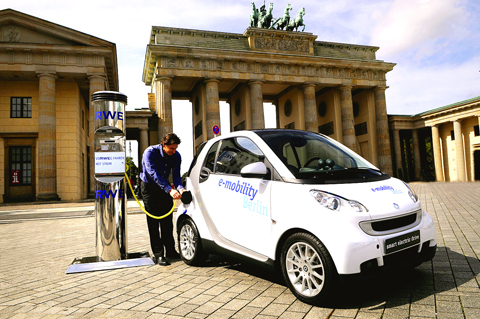What shape will the plug for recharging your future electric vehicle take?
That question is becoming a pressing matter for automakers. The global auto industry has yet to agree on a standardized shape for the connectors that will replenish the batteries of electric cars, though the Society of Automotive Engineers has been working on standards for such a plug for more than two years.
Issues of this sort must be resolved before many of the electric powertrains displayed at the Detroit auto show this month will be able to take to the road in large numbers. While the breadth and diversity of electric car proposals seen in Detroit seemed to affirm their inevitability — despite obstacles like US$0.52 per liter gas at nearby pumps and a grim car market overall — the efforts at electrification of the vehicle fleet, to use the buzz phrase of the moment, also raised awareness of the challenges that automakers will face.

PHOTO: NY TIMES NEWS SERVICE
Making the electricity available to recharge batteries is just one of the hurdles carmakers must address. How far the cars will go on a charge, how long the recharging process will take, and even how drivers will be billed for electricity when they recharge away from home, are also matters that engineers are scrambling to sort out.
David Champion, director of auto testing at Consumer Reports, said that the promises being made for electric cars are sure to lead to some buyer disappointments. Commenting on vehicles he saw at the Detroit show like the Chevrolet Volt — a plug-in hybrid with a 64km all-electric range, which General Motors says will go on sale late next year — he noted that the ranges are mostly predicated on low speed and intermittent city driving, where an electric powertrain shines.
“You get that vehicle out on the highway and cruise along at 70 miles per hour [112kph], that range is going to plummet,” Champion said.
The Volt’s powertrain design, generally referred to as a series hybrid, incorporates a gasoline-driven generator that can keep the car going until it can plug in for a recharge.
Add the amenities that Americans expect in their cars — air-conditioning turned up high, audio systems set to deafening levels — and battery-powered vehicles may be spending as many of their kilowatt hours on comfort as they do on cruising.
The issue puts pressure on engineers to reduce charging time. In news conferences during the show’s press preview days, the hours-to-recharge figure seemed to be the newest bragging point for some automakers, replacing zero-to-60 times and fuel-efficiency ratings as the numbers that mattered.
The Mini E, for instance, can be recharged in just 2.5 hours using a special home charging station. The battery-powered Minis — 500 are being leased to individuals in the Los Angeles and New York metro areas for one-year terms — can also be recharged on household current. But if the current comes from a standard 110-volt wall socket, it will take 23 hours to restore the car’s 240km maximum range.
Public charging stations were announced for the Smart Electric Drive cars that are part of a 100-vehicle Berlin test fleet to be put on the road this year. The stations include a link to a computer chip in the car that allows charging with the lowest-cost electricity, choosing off-peak times, and possibly even selecting green energy sources by detecting when wind farms or solar panels are feeding to the energy grid.
BYD, a Chinese carmaker, may have trumped them all. It showed the F3DM plug-in hybrid, already on sale in China, and said that although normal battery-pack charging using home current would take nine hours, special “industrial” charging could snap the battery back to 80 percent of capacity in 15 minutes. BYD did not describe the industrial charging system.
Hybrids like the Toyota Prius are not limited by battery capacity, since they run on their gasoline engines for most driving. Toyota announced in Detroit that it would lease a plug-in version of the Prius to commercial customers later this year. The car will be equipped with lithium-ion batteries, which can provide a longer range than the nickel-metal hydride batteries in the regular Prius.
But at the Detroit show this year the momentum in plug-in hybrids seemed to be swinging toward series hybrids, in which the piston engine drives only a generator to charge the battery, with no mechanical connection to the wheels. General Motors calls this solution, used for the Volt and seen also in the Cadillac Converj design study, an extended-range electric vehicle, and the terminology seemed to be catching on with other automakers.

AIR SUPPORT: The Ministry of National Defense thanked the US for the delivery, adding that it was an indicator of the White House’s commitment to the Taiwan Relations Act Deputy Minister of National Defense Po Horng-huei (柏鴻輝) and Representative to the US Alexander Yui on Friday attended a delivery ceremony for the first of Taiwan’s long-awaited 66 F-16C/D Block 70 jets at a Lockheed Martin Corp factory in Greenville, South Carolina. “We are so proud to be the global home of the F-16 and to support Taiwan’s air defense capabilities,” US Representative William Timmons wrote on X, alongside a photograph of Taiwanese and US officials at the event. The F-16C/D Block 70 jets Taiwan ordered have the same capabilities as aircraft that had been upgraded to F-16Vs. The batch of Lockheed Martin

GRIDLOCK: The National Fire Agency’s Special Search and Rescue team is on standby to travel to the countries to help out with the rescue effort A powerful earthquake rocked Myanmar and neighboring Thailand yesterday, killing at least three people in Bangkok and burying dozens when a high-rise building under construction collapsed. Footage shared on social media from Myanmar’s second-largest city showed widespread destruction, raising fears that many were trapped under the rubble or killed. The magnitude 7.7 earthquake, with an epicenter near Mandalay in Myanmar, struck at midday and was followed by a strong magnitude 6.4 aftershock. The extent of death, injury and destruction — especially in Myanmar, which is embroiled in a civil war and where information is tightly controlled at the best of times —

China's military today said it began joint army, navy and rocket force exercises around Taiwan to "serve as a stern warning and powerful deterrent against Taiwanese independence," calling President William Lai (賴清德) a "parasite." The exercises come after Lai called Beijing a "foreign hostile force" last month. More than 10 Chinese military ships approached close to Taiwan's 24 nautical mile (44.4km) contiguous zone this morning and Taiwan sent its own warships to respond, two senior Taiwanese officials said. Taiwan has not yet detected any live fire by the Chinese military so far, one of the officials said. The drills took place after US Secretary

THUGGISH BEHAVIOR: Encouraging people to report independence supporters is another intimidation tactic that threatens cross-strait peace, the state department said China setting up an online system for reporting “Taiwanese independence” advocates is an “irresponsible and reprehensible” act, a US government spokesperson said on Friday. “China’s call for private individuals to report on alleged ‘persecution or suppression’ by supposed ‘Taiwan independence henchmen and accomplices’ is irresponsible and reprehensible,” an unnamed US Department of State spokesperson told the Central News Agency in an e-mail. The move is part of Beijing’s “intimidation campaign” against Taiwan and its supporters, and is “threatening free speech around the world, destabilizing the Indo-Pacific region, and deliberately eroding the cross-strait status quo,” the spokesperson said. The Chinese Communist Party’s “threats